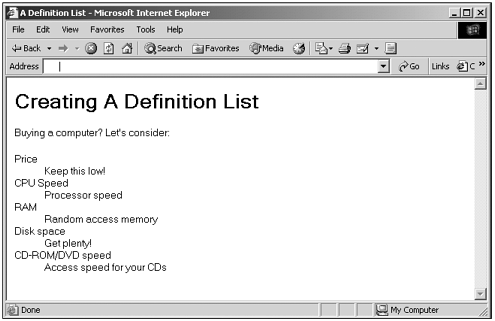The DL , DT , DD , DIR , and Elements
The <DL> , <DT> , <DD> , <DIR> , and <MENU> ElementsThe <DL> , <DT> , and <DD> elements enable you to set up definition lists, which list terms and their definitions in pairs. You create a definition list with the <DL> element, and create items in this list using both the <DT> element to define a term and the <DD> element to give the term's definition. The definition usually appears indented under the term being defined. Here's an example: (Listing 14-08.html on the web site)<HTML> <HEAD> <TITLE> A Definition List </TITLE> </HEAD> <BODY> <H1> Creating A Definition List </H1> Buying a computer? Let's consider: <DL> <DT>Price<DD>Keep this low! <DT>CPU Speed<DD>Processor speed <DT>RAM<DD>Random access memory <DT>Disk space<DD>Get plenty! <DT>CD-ROM/DVD speed<DD>Access speed for your CDs </DL> </BODY> </HTML> You can see this page in Figure 14.4. Figure 14.4. Using a definition list. There are even more list elementsthe <DIR> and <MENU> elementsbut they are deprecated in HTML 4.01 and are just treated as <UL> elements. You can see the properties of the <DL> , <DT> , and <DD> elements in Table 14.6. Remember that JavaScript's core HTML properties, methods , and events, which we covered in Chapters 5 and 6, apply to the <DL> , <DT> , and <DD> elements as well. Table 14.6. The Properties of the <DL> , <DT> , <DD> , <DIR> , and <MENU> Elements (See Chapters 5 and 6 for the JavaScript core HTML properties, methods, and events that also apply to these elements.)
| ||||||||||||||||||||||||||||||||||||||||||||
